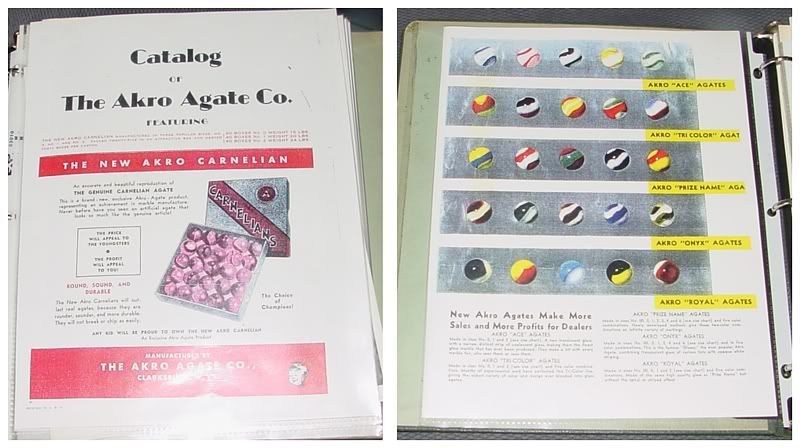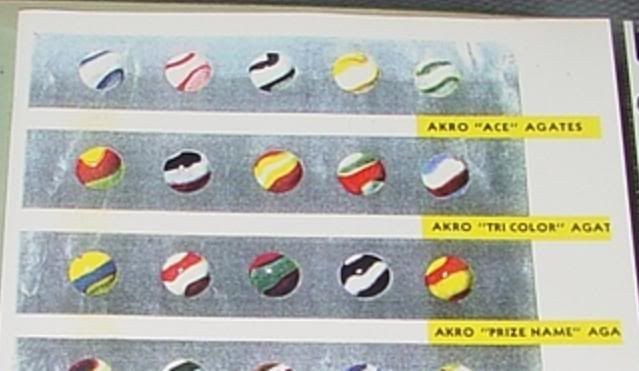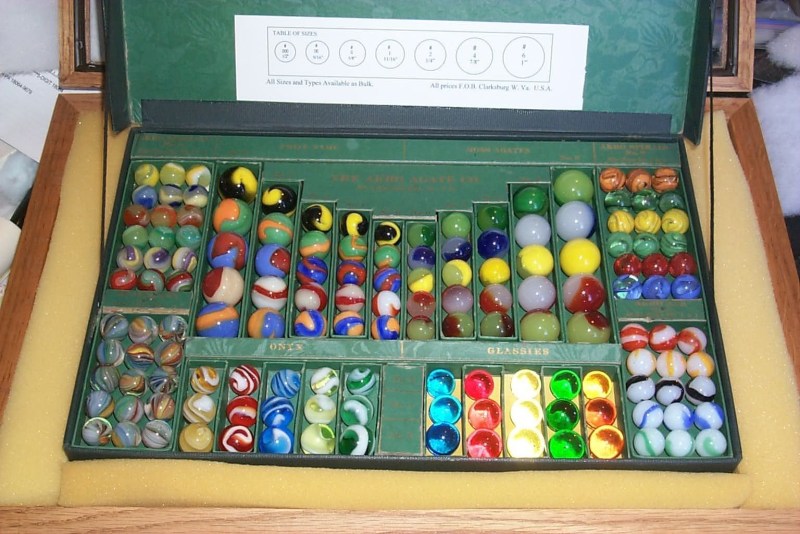-
Posts
29295 -
Joined
-
Days Won
38
Content Type
Profiles
Forums
Gallery
Events
Everything posted by Steph
-
Might as well start one. :-) Company history: 1886 to present (last I heard) Peltier Glass Company website Victor J. Peltier bio page at Rootsweb
-
Indeed he does. :-)
-
Early 1930's, Catalogs and other circulars of uncertain age [coming soon] lol - "coming soon". How long have I been saying that? Here's one of the pages I keep planning to incorporate. I can't seem to get them all together at once. So I'll just start here: I have "1930ish" on these photos from Dani. I have bigger copies somewhere. .... Here's one example of why they're of such uncertain age! WARNING: it's complicated. I'm still working on a better way to say it. It will likely become easier, or unnecessary, as I include more examples. This illustration of the No. 32 and No. 64 display cartons was recycled into multiple brochures. This particular example came from the scan Dani posted. http://i119.photobucket.com/albums/o151/modularforms/Akro/DisplayCartons_Dani-1.jpg. In Dani's version, the descriptions of the contents do not match the illustrations. The original descriptions might actually have been the ones shown in the catalog on p. 17 of American Machine-Made Marbles. Page three of the catalog. Here are the contents from that page: No. 32: No. 64: If you are aware of Moss Agates once having been a swirled type of marble, you might recognize them through the windows in the cartons. These are the kind which have "exquisite patterns", as described in some ads. They include the Ades and the Blue Eggyolks. Here is a sample box of that sort of Moss Agate, with salesman's price label affixed. (click to enlarge) (click the links below the thumbnails for the larger copies) http://i119.photobucket.com/albums/o151/modularforms/Akro/th_MVC-018S.jpg http://i119.photobucket.com/albums/o151/modularforms/Akro/MVC-018S.jpg http://i119.photobucket.com/albums/o151/modularforms/Akro/th_MVC-019S.jpg http://i119.photobucket.com/albums/o151/modularforms/Akro/MVC-019S.jpg http://i119.photobucket.com/albums/o151/modularforms/Akro/th_MVC-020S.jpg http://i119.photobucket.com/albums/o151/modularforms/Akro/MVC-020S.jpg http://i119.photobucket.com/albums/o151/modularforms/Akro/th_MVC-021S.jpg http://i119.photobucket.com/albums/o151/modularforms/Akro/MVC-021S.jpg In post #10 here, Intriguing Akro Box, Clyde describes another box like this. HOWEVER, though the contents listed on page three of the catalog in AMMM match the illustration on that page, there are several inconsistences between that page and the others. I won't try to be more specific at the moment because if you don't have the catalog in front of you, the comparison would shoot 18 light years past "complicated". And if you do have the catalog in front of you, then you might want to try to sort the consistencies out yourself.
-
Copyright 1931, The Akro Kings game There is also Click. What year was that? Sliding this in: 1931, Big Time Marbles Comic/Ads in Boy's Life Magazine. Old-fashioned looking cartoon boys - I think the same cartoon boys used on the Ringer Marble Sets
-
Sometime in 1930, and I'll have to guess toward the end of the year. This is from a reproduction of a 1930-1931 catalog, image sent by George Sourlis. It places Akro's original Tri-color agates in 1930 (Note, the original tri-color agates were corkscrews, i.e., the mibs we call "specials" today). And it calls 'em Rainbow! (click to enlarge) The marbles: Cover: Dec. 1930 On p. 11 of The Complete Line of The Akro Agate Co. (1992), the Hardy's show an ad for "this new Akro Agate game called CLICK". Also mentioned in the ad is a "new Akro Agate Prize Contest". (still waiting to hear the outcome on the old one!) Also mentioned are "three new Akro Agate assortments with marble bags". Click game, from a Block auction. (click to enlarge)
-
The 1930's Don't know the year on this, but it's a classic. Likely after Feb. 15, 1932 considering the size on the Glassies. See later post. (click to enlarge) I have some close-ups to add at a later date.
-
1929 - 1930, the birth of the corkscrew and the last days of the slag 1930, The Prize Name Naming Contest Akro Prize Name box with contest coupons. (click to enlarge) (source) Some text from the enclosure introducing the prize names and explaining the contest: Then came the contest rules. There were to be five prizes, ranging from $10 to $100. The deadline for entries was Midnight, May 1, 1930. And winners were to be announced in the June issue of Boys' Life. I have a copy of that issue but do not see anything from or about Akro. Presumably the original color combinations: I believe that some ads continued to list these combos even though more were available very soon.
-
1929 April 1929 -- Cracker Jack promotion http://i119.photobucket.com/albums/o151/modularforms/Akro/crackerjackads-2.jpg . . . http://i119.photobucket.com/albums/o151/modularforms/Akro/crackerjackads2-2.jpg a few extras. A coupon which might have come in a Cracker Jack box, and what is said to be a Cracker Jack prize from 1928. The wrapper says "Genuine Agate". Supposedly the "right" marble to find in the wrapper is a red and blue swirl. This is according to a Cracker Jack specialist, not an Akro specialist. I am not aware of a red and blue marble made by Akro in 1928. http://i119.photobucket.com/albums/o151/modularforms/Akro/th_CJAAGATE_016-1.jpg http://i119.photobucket.com/albums/o151/modularforms/Akro/th_CJAAGATE_017-1.jpg http://i119.photobucket.com/albums/o151/modularforms/Akro/th_1928_CJ_RedBlueSwirl.jpg July 1929 -- Jobbers Price List July 1929 -- Jobbers Price List. I should have a larger, crisper version somewhere. Sliding this in ... is 1929 the year of the pivotal lawsuit against Peltier?
-
(in process of reformatting this one, bringing together material from multiple sources) 1929 and later -- "Imperials" IMHO, and in the more educated opinion of some others, the original imperials were silver oxbloods. After that many different, premium types of Akros were distributed in the Imperial boxes. Perhaps the originals didn't go over as well as had been hoped and there were surplus boxes. Letter introducing Imperials, dated January 23, 1929 (click the links below the thumbnails to enlarge) http://i119.photobucket.com/albums/o151/modularforms/Akro/akroimperialadp1.jpg http://i119.photobucket.com/albums/o151/modularforms/Akro/akroimperialadp2.jpg http://i119.photobucket.com/albums/o151/modularforms/Akro/akroimperialadp3.jpg Part of the progression of "Imperials": (click the links below the thumbnails) http://i119.photobuc...erialFromAd.jpg http://i119.photobuc...o/MVC-010S1.jpg http://i119.photobuc...ro/MVC-011S.jpg http://i119.photobuc...ig_mc7055_b.jpg http://i119.photobuc...orVersion-2.jpg The 2nd to last box was Craig's but this is the marble Craig calls an Imperial. He had it for sale in December: Edit: I think Craig's box was backfilled from marbles in a huge lot of new old stock he acquired.
-
Perhaps 1926 or 1927. The slags and the art make it seem like it could be a 1920's item. To the best of my ability to judge. We might learn a lot from comparing notes with a vintage fashion site, huh? :-) O' Boy! gift box. (click to enlarge) From the Marquee auction description: I actually found many ads with ties being sold with various items. But usually only one item. Tie & marbles. Tie & harmonica. Tie & pencil. to name a few examples. So if those came all together I guess that was pretty special. The tie could be silk or rayon. Maybe others materials. It might be a bow tie or a "four-in-hand". Or just a boy's tie without specifying. The earliest ad I recall at the moment was from 1926. One 1926 ad actually specified the Akro brand. That wasn't the usual practice. Another 1926 ad said the marbles in the tie set were imported. Anyway, here are a 1926 ad mentioning Akro and a 1932 ad with a drawing of a gift set. (click to enlarge) . .
-
1926 A folded pricelist from Akro, found with a 1926 letter advertising Cornelians. The pricelist is sealed with a 1 1/2 cent Warren Harding stamp. (click to enlarge) The Cornelian letter:
-
1926 All About Marbles, A Little Book for Boys Published by Akro Agate, Clarksburg, W. Va. (click to enlarge) The 4 page advertisement insert starts here: A closer up shot of the Cardinal Reds and Cornelians. Impressive detail: (click to enlarge)
-
A spare block for early to mid 1920's
-
A block for early 1920's 1922 Ira Freese applied for a patent for a gob feeder. His gob feeder had nothing to do with corkscrews or their eyelashes.
-
Another Block for 1910's
-
Original content moved, leaving spare space for now
-
The white on Rookie's looks like it's intentional to me. Looks like an "ordinary" white based rainbo with a little something extra in the colored bands. (to me)
-
Happy Dave Day!
-
Felicia, I don't know about the burring. One description I read said that the cutter would have burrs right after sharpening, leading to eyelashes. Then they would wear down, and eyelashes would diminish. Others have argued about that. My amateur brainstorming makes me think they might due more to the geometry of the marble or of the cutline, and general properties of glass, rather than irregularities on the edge of the cutter. Which other marbles are known to have eyelashes? Masters. Imperials. Anything else? Here's an Imperial up against Rookie's best eyelash pic. (click to enlarge) Reminds me of pleats. Is that tugging? Or is that puckering? Maybe it's a combo of tugging and bunching. If it appears more often in akros than in others, pehaps the torque of corks accentuates it. just a thought.
-
Lisa's right. You're a great sport! I do not know what could be considered "true" about using the term "pre-freese" to describe a corkscrew. The best information we have is that the Freese machine was not used for marble making. It was intended to be, but never made it. Whoever stuck the Freese name on any Akro marbles made a booboo. Continuing to use it perpetuates the misunderstandings associated with it. Your more immediate concern is that it could reflect badly on your auctions. It increases the likelihood of more threads like this on the various marble boards because the use of the term sets off alarms. People who use it are often written off as uninformed or as hucksters. Being mentioned once or twice in a thread like this doesn't mean much. Especially while you're getting the hang of ebaying. But the more often a seller's auctions get flagged, the more likely the seller's name is to be remembered in a negative light. Ya need to ditch the word "Freese" altogether to help that not happen. You don't need the word. Akro corkscrews are vintage. Period. If you wish to focus on eyelashes in your auctions, that is a fine thing to do. It would be better just to focus on the eyelashes themselves though. As a classic feature. Without bringing the word Freese into it. IMHO. :-)
-
There are Whities with that sort of header, though a silver or gray background, not red. These appear to have the rich ribbons. They are pictured in an ad with Blackies, Cat Eyes, and Aqua Jewels. The presence of cat eyes date the ad to 1954 or later. Maybe as the Blackies came closer to what we think of as Blackies, the Whities became closer to what we think of as Blackies also. (pure conjecture) This was in a very very very cost-conscious time. (not conjecture) If the super nice seeming whities were made intentionally with a better white base at first, it would make sense for that to be considered less important in 1955 and later, as Vitro was battening down the hatches against the Japanese Cat Eye storm. As it was, All-Reds cost twice as much as Japanese Cat Eyes in 1960. So, if Whities cost even more to make, then (a) it's not surprising that they didn't last long, and (b ) it wouldn't be surprising if their quality declined before they were discontinued. p.s., two Vitro time-line threads I am/was/might be working on: Vitro Time Line (with info from the Vitro book) Vitro Bag Headers
-
Ah, I see that in AMMM about blackies coming first. I also see that I pretty much repeated what you were saying about depth of color and such, and you're being very polite about not saying, WELL DUH :-) Sorry, my brain has been somewhere else. FWIW the earliest Blackies might not be Blackies as we know them so just knowing dates, like from a dated price sheet, might not be enough for making judgements about when different styles were made. I think these may be some of the earliest. Derrick's bag. He says they're transparent inside.
-
There are some things I also wonder about. Some of the whities do look different to me. As if possibly they are not veneered marbles (*said with caution*). I do not fully undertand the the meaning of the term "veneer" as used by marble companies. But some do look different, whatever the name of the process by which they were made. I'm thinking about the ones with the deeper, transparent ribbons. Yet the blue blackie just left of center in your photograph seems to have some depth to the black ribbon. If Whities started out before Blackies then that might explain the difference on that one variation. I suspect the during the time of their overlap they would have had the same type base glass, or for most of the time of overlap anyway. On the other hand, if they had different base glass, some of one type could still get into bags of the other type because if Vitro employees were running low on anything they would make do. I think it is that general casualness, at least in part, which makes my friend with the beaucoups bags disinclined to find much percentage in trying to pin down which is a white blackie and which is a black whitie. I need to confirm/review some of this. I'm reporting on and extrapolating from discussions partly about blackies but mostly of other types, so I need to go back and see if I'm overgeneralizing or plain old speaking out of turn. I also need to double check when Whities and Blackies were made: which came first, how long each was made, and perhaps a comparison between # of blackies made and # of whities. Some info comes from ads. Some inferences are drawn from headers on bags. Some comes from Vitro employees. Etc. ?? Some simply isn't known.
-
The term "pre-freese" has been severely mis-used, even on this site. In a thread where Brian pointed it out as a myth, someone came on afterwards and called him an idiot. Sue was polite and invited explanation, but the fun atmosphere of the thread was pretty much destroyed and no one responded in it again. (I might go do that now.) The term has been used to mis-date marbles. You used it to conclude that your corks were made before 1920. They weren't though. One of the patents for essential cork-making machinery wasn't filed until 1928. It seems likely that the cork process was perfected during 1929. The earliest known cork advertisement is from Spring 1930. Yes, I see eyelashes on your corks. Really nice ones in the first pic. But they have nothing to do with Ira Freese's 1922 gob feeder. Sorry. :-(
-
I have been told by someone with beaucoups Vitro bags that the same type of white marble with black bands was sold in both whities and blackies bags. Someone else, who had two different looking white Vitros with black bands, proposed that one was a white blackie and one a black whitie. But I believe the bag owner's position would be that such a division would not make sense, that one would find a range of types of black even in whities bags. One certainly would in blackies bags. Look at the range of "black" simply on the blackies you show here: Pick another color. Say blue. What range of blue do you find on your whities? The few you have showing suggest to me that there might be much variation in any "single" color. If I understand correctly, quality control was not job 1 in the Vitro factory. Or not the sort of quality control which would result in consistently higher quality in one marble type than there was in another marble type made in, say, the same month.









